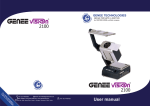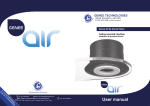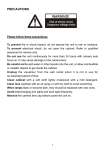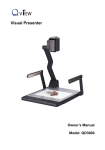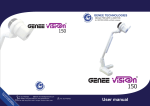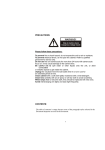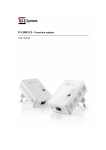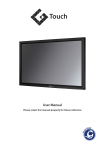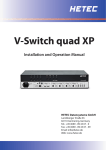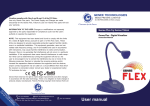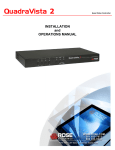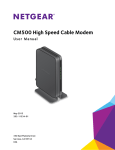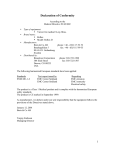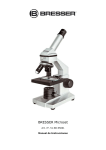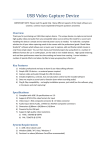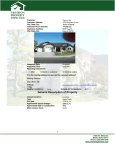Download User manual - Genee India
Transcript
GENEE TECHNOLOGIES INDIA PRIVATE LIMITED ® An ISO 9001:2008 certified company Classroom for the Future 6100 ® 6100 Classroom for the Future Tel: 0124-4934500 @ Email: [email protected] Website: www.genee-india.com, www.geneeworld.com WWW Plot No. 698, Udog Vihar, Phase V, Gurgaon, Harana-122016, India Fax: 0124-4934521 User manual PRECAUTIONS REMOTE CONTROL & CONNECTIONS POWER (Control the visualiser On/Off) SAVE (Save captured images) RECALL (Display saved images) EXIT (Exit RECALL mode) LAMP (Control the arm lights and back light) FREEZE (Freeze the image) NEG (Display film negatives) MIRROR (V-Reverse the image) SPLIT (Image split function) D./S. (Switch between static mode and dynamic mode) XGA (Switch between XGA (1024 x 768) and SVGA (800 x 600) mode) B&W (Switch between color mode and B&W mode) TITLE (Freeze the top 1/8 of the screen) PROJECTOR POWER (Control the projector On/Standby) PROJECTOR INPUT (Projector input signal selection) TEXT (Switch between image/text mode) AUTO (To auto white balance and auto focus) TELE/ IDE (Increase and decrease the magnification) FAR/NEAR (Focus near or far) VOL+/VOL- (Increase or decrease the volume) CCD/PC1/PC2 (CCD/RGB input signal selection) VIDEO (Video input signal selection) RED +/- (Increase/decrease the red hue) BLUE +/- (Increase/decrease the blue hue) BRIGHT +/- (Increase/decrease the brightness) SCROLL / (Move the image up/down) Please follow these precautions: To prevent fire or shock hazard, do not expose the unit to rain or moisture. To prevent electrical shock, do not open the cabinet. Refer to qualified personnel for service only. Do not use the unit continuously for more than 24 hours with camera auto focus on. It may cause damage to the camera lens. Be careful not to spill water or other liquids onto the unit, or allow combustible or metallic objects to get inside the cabinet. Unplug the visualiser from the wall outlet when it is not being used for a long period of time. Clean the cabinet with a soft cloth lightly moistened with a mild detergent solution. Clean the lens carefully with an air spray or soft dry cloth to avoid scratching it. When the lamps flash or become dark, they should be replaced with new ones. Avoid switching arm lights and back light frequently. Remove the camera lens cap before power the unit on. NOTE: FREEZE, TITLE, D./S. and SPLIT functions are only available on PROJECTOR OUT port. REAR PANEL 7 OUT OUT AUDIO VIDEO S-VIDEO IN 8 IN AUDIO VIDEO AUDIO S-VIDEO AUDIO IN OUT -COMPUTER- IN PROJECTOR OUT-12V- IN Panel PANEL SIDESide 18 PROJECTOR MIC USB RGB IN AUDIO IN 2) VIDEO OUT 1) AUDIO OUT 5) VIDEO IN 4) VIDEO AUDIO IN 8) PC AUDIO IN 7) S-VIDEO IN 11) COMPUTER IN 10) COMPUTER OUT 13) PROJECTOR RS232 Connector 16) RGB IN 15) USB Connector 18) COMPUTER RS-232 Connector RS232 3) S-VIDEO OUT 6) S-VIDEO AUDIO IN 9) PROJECTOR Connector 12) POWER OUT/IN 14) MIC IN 17) RGB AUDIO IN BASIC PREPARATIONS PARTS IDENTIFICATION 1. Use one hand to hold the base of the visualiser, use the other hand to carefully lift up the camera stand of the unit. Camera Camera stand Arm lights Button instruction Connectors 2. Open the arm lights and rotate the camera head until they are in proper positions. Back light Remote control slot Connectors Stage Operation panel Arm lights CCD/PC1/PC2 6100 6100 Mir Frz Neg VIDEO Title Far Ppw Pin POWER (Control the visualiser On/Off) Mir (V-Reverse the image) Frz (Freeze the image) Neg (Display film negatives) Title (Freeze the top 1/8 of the screen) D./S. (Switch between static mode and dynamic mode) Far/Near (Focus far or near) Split (Image Split function) POWER + LAMP T W AUTO Ppw (Control the projector On/Standby) Pin (Projector input signal selection) / (Move the image up/down) (Optional) CCD/PC1/PC2 (CCD/RGB input signal selection) VIDEO (VIDEO input signal selection) LAMP (Control the arm lights and back light) AUTO (To auto adjust white balance and auto focus) T/ (Increase and decrease the magnification) Remarks: Frz, Title, D./S. and Split functions are only available on PROJECTOR OUT. 3. Making connections: Before making any connection, turn off all the power, including power of the visualiser and the equipment to be connected. Step 1: Connect power source. First connect the power cord to the 12V IN connector. 4: Connect to the projector. 6: Connect to the first video equipment with S-Video input. Rear Panel OUT OUT AUDIO VIDEO IN S-VIDEO AUDIO VIDEO S-Video Cable S-Video out IN AUDIO S-VIDEO AUDIO IN PROJECTOR OUT -COMPUTER- IN OUT-12V- IN Audio out Video equipment Rear Panel OUT AUDIO RS232 Cable Side Panel RGB IN AUDIO IN AUDIO VIDEO AUDIO S-VIDEO AUDIO IN RS232 Connect visualiser’s PROJECTOR port to the RGB IN port of the projector port with the RGB cable provided together the visualiser. If you need control a projector with the visualiser, please use the projector RS232 cable (6-pin to 9-pin) to make the connection between the projector and the visualiser. Some projector models may require a converter cable in addition to this standard RS232 cable to connect to the projector control port, for the pin locations and shape of some projectors’ control port connector may be different from the connector of a standard RS232 cable. After the visualiser is connected to the projector, you can control projector’s power on, standby and input selection with the visualiser. (For projectors other than Hitachi, the Code Writing program that comes with the visualiser is required for this function.) Video Cable Video out Audio out Video equipment Audio out Rear Panel Rear Panel OUT IN OUT VIDEO S-VIDEO AUDIO AUDIO OUT IN IN IN VIDEO AUDIO S-VIDEO VIDEO S-VIDEO AUDIO AUDIO IN VIDEO PROJECTOR AUDIO OUTS-VIDEO -COMPUTER- AUDIO IN Projector Color monitor Video in Video in Rear Panel AUDIO VIDEO S-VIDEO AUDIO VIDEO AUDIO S-VIDEO AUDIO IN PROJECTOR OUT -COMPUTER- IN OUT-12V- IN Side Panel To the Monitor PROJECTOR MIC USB Connector RGB Output USB Side Panel RGB IN AUDIO IN RS232 RS232 Cable Computer PROJECTOR MIC USB RGB IN PROJECTOR MIC USB RGB IN AUDIO IN AUDIO IN RS232 RS-232 cable USB cable Note: You can connect a laptop computer to the RGB IN port of side panel with a RGB cable. OUT-12V- IN Video out AUDIO IN IN Video Cable Projector Color monitor IN -COMPUTER- 7: Connect to the second video equipment with video input. OUT OUT OUT Output of the S-Video signal from the visualiser to the projector is already done in the step 2, where the RGB cable comes out from the visualiser and goes to the projector. After the connections as steps 2, 3, 4 are made, input signals from the computer visualiser CCD and S-Video are going to the RGB1 input on the projector and will be displayed on the projector screen as RGB1. These signals can be seen in turn when pressing “CCD/PC1/PC2” and “VIDEO” on the control panel of the visualiser. Remarks: RGB IN signal can not go to S-VIDEO OUT or VIDEO OUT port to be displayed on the screen. Video equipment 5: Connect to a desktop computer. OUT PROJECTOR Audio input Screen Projector USB S-VIDEO Projector (or amplifier/speaker equipment) RGB Input PROJECTOR MIC VIDEO IN IN OUT RS 232 connector RS232 of the computer Side Panel USB connector of the computer USB cable RS-232 cable RS 232 connector of the computer USB connector of the computer IN OUT-12VIN PROJECTOR OUT -COMPUTER- IN OUT-12V- IN SETUP GUIDE Use the computer RS232 cable (9-pin to 9-pin) to make the connections shown below to control the visualiser from an external computer. USB connection enables capturing still images / video streams from the visualiser to the computer. Special software is required for this operation. 8. Turn on the power by pressing the “POWER” button. Plug in here Plug monitor/pc in here INSTALLING VISUALISER SOFTWARE Set up 1 USB Set up 1 RGB in projector comp in The simplest set-up, using the RGB lead, to project images on to a screen. PROJECTOR Set up 2 LAPTOP 2 USB RGB RGB in ? projector USB comp in RGB MAIN PC/ LAPTOP PROJECTOR connected to interactive board Set up 3 Set up 2 This set-up allows you to toggle between the Visualiser, the PC / laptop running the interactive whiteboard and an optional, second (non-interactive) computer input. The USB lead can be connected to either computer depending on which one you wish to capture Visualiser images on to. USB 1. Insert the CD-ROM that comes with your visualiser into the CD-ROM drive. If Autorun is enabled on your system, then the Software Setup window will be displayed automatically as below. If it does not start automatically, after inserting the CD-ROM, Click [Start] -> [My Computer], and double click (the CD-ROM drive letter might be different among different computer systems), then the above screen will appear immediately. 2. Click the Install Code-Writing Program button to install Code-Writing Program. 3. Click the Install DirectX9.0 button to install Microsoft DirectX 9.0. 4. Click the Install Capture Program button to install the program that captures images in the AVI or Bitmap format. 5. Click the Install USB Driver button to install the driver designed for the visualiser and will be used by the Capture Program. 6. After the installation is finished, then click the Exit button to exit the Software Setup window. 7. Shut down your computer when prompted so the changes will take effect. 8. Use the USB cable to connect your computer to the visualiser before your computer is restarted. 9. Turn on the visualiser. Remarks: DirectX9.0 is not necessary to install, it is mainly for computer print screen function. Please pay attention to the following: 10. Computer hardware requirement: CPU: Pentium 4, RAM: 256M or above, USB 2.0 port, Hard disk 40G or more. (front) USB 11. Operating system: Windows 2000 or above. If the operating system is Windows 2000, should install SP4. If the operating system is Windows XP, should install SP1. projector 12. Must use the high-speed USB cable provided together with the visualiser. comp in 13. When connect the visualiser to a desktop computer with the high-speed USB cable provided together with visualiser, we recommend using the USB port on the rear of the mainframe as the USB port on the front of the computer might have interference. USB RGB PROJECTOR This function is to snap and display images with the USB interface, which includes displaying static and dynamic pictures, snapping dynamic images and playback the dynamic images with the Windows Media Player or its own player. PC/LAPTOP 14. You need to install the USB driver again when you change a computer’s USB port. If this port has installed USB 2.0 driver, then no need to install USB driver again. Set up 3 15. When you open capture program, but can not capture the image, please set the signal input source: click “Option” “Video Crossbar”, and then set INPUT as S-Video IN. SET UP GUIDE This set-up allows you toggle between the Visualiser and the interactive desktop, using the CCD/PC1/PC2 button (no input on PC2). Any Visualiser still-image can be captured to the desktop using the ‘VideoCap’ software (on the Genee Vision disk), or moving image using programs such as ‘Movie Maker’ which comes with Windows XP. Copy the folder “Mac Driver” into Mac hard disk, open the folder and double-click Empia 1.0.0b2. zip, the “setup” file appears. Follow dialog-box messages, click “next” and finish installation. Note: 1. Please connect Mac computer and visualiser when installing 2. Please use USB2.0 from visualiser accessories. PROJECTOR INPUTS SELECTION When the projector is connected to several input sources, use the “Pin” button to switch signal inputs of the projector. (On the remote control, press the “PROJECTOR INPUT” button) Note: Please connect the projector RS232 cable between the projector and the visualiser first. If you cannot switch projector inputs by pressing this button, you need to manually program the RS232 code into the visualiser. See the section “Controlling Projector with Visualiser” for detailed instruction. WORKING ON THE STAGE 1. Place your material on the working surface. 2. Select the enlargement required with the “ T” and “W” keys. 3. Adjust the focus with the “Near” and “Far” keys or “AUTO” key. IMAGE REVERSION Press the “Mir” button once to V-reverse the image and the vertically mirrored image will be displayed. Press the “Mir” button again to exit. (On the remote control, please press the “MIRROR” button) WORKING OUTSIDE THE STAGE For showing 3-dimensional objects, just place them on the working surface and adjust the “ T” or “W” and “AUTO” keys. If the object is too big for the stage or you want to show it from the side, just place it behind or in front of the unit and tilt the camera by hand (please take off the close-up lens first). IMAGE SPLIT Press “SPLIT”, the image will be split into two images. One is the current captured image the other is a frozen image of the last image, Press the “SPLIT” button again to exit. Note: This function is not available on S-Video and Video output. USB CAPTURE FOR MAC COMPUTER LIGHT The arm lights are on when the power is on. Each time you press the “LAMP” buttons, the lighting changes as below. The arm lights turn on Rotate 330 degrees vertically The back light turns on All the lights turn off ADJUSTING IMAGE SIZE In order to reduce or enlarge the image size displayed on the screen, press the “ T” or “ ” button. WORKING WITH NEGATIVES The visualiser is automatically set to display normal materials on the screen when the power W is on. To display negatives, turn on the backlight by pressing the “LAMP” key, and then press the “Neg” button to display the film negatives. Press the “Neg” button again to display normal materials in the colour mode. DYNAMIC/STATIC MODE SWITCH To display dynamic images, Press the “D./S.” button to switch to the Dynamic mode, the image will be clear and has no choppy strobe effect. To display still images, press the “D. / S.” button switch to the Static mode.Note: This function is not available on S-Video and Video output. TITLE FUNCTION Press the “Title” button once, the image split into two parts, the upper 1/8 part of the image will freeze and stay on top 1/8 of the screen. Press “Title” button again to exit the Title mode. Note: This function is not available on S-Video and Video output. IMAGE SAVE AND RECALL Press the “SAVE” button once to save one captured images, it can save up to 7 images. After 7 images are saved, the 8th image will replace the previous 1st image and will become the new 1st saved image.(On the remote control) Press the “RECALL” button once to display the saved images, then press the numerical button to show the corresponding image. For example: Press “2” to display the second image. At this status, the function under each numeric key is not available. Press “RECALL” again to exit this mode. (On the remote control) INFRARED REMOTE CONTROL The visualiser’s remote control can control the camera from different angels. Please note that an infrared remote control can only be used up to a certain distance to the unit. Objects situated between the visualiser and the infrared remote control and a weak battery may interfere with the reception. On the left side of the visualiser stage, there is a built-in remote control storage compartment where you can store the remote control when you not use it. IMAGE SCROLLING (Optional) Press the “ ” button to scroll the image down to display the upper part of the image. Press the “ button to scroll the image up to display the lower part of the image. USB PORT (Optional) The USB port can be used to transfer still images from the visualiser to a computer. No additional computer hardware is required. In this way, the visualiser can be used as a 3-D scanner for your computer. Connect the visualiser to your computer with the supplied USB cable. The Visualiser Software is available on the supplied CD-ROM. SWITCHABLE RGB INPUTS Use the “CCD/PC1/PC2” button to switch between CCD and different RGB signals. Each time the “CCD/PC1/PC2” button is pressed, it provides seamless transitions among different sources such as Camera (CCD), COMPUTER(IN) and RGB (IN). Notes: COMPUTER OUT always outputs COMPUTER IN signals. FOCUSING When the visualiser is turned on the focus automatically adjusts to the stage, it is not necessary to readjust the focus if you are only working with flat materials (text, photos, etc.). Only 3D object require a focus adjustment. Press the “AUTO” button to auto focus. Press the “FAR” or “NEAR” button once to focus manually. PROJECTOR ON/STANDBY Press the “POWER” button to turn on the visualiser’s power and press the “Ppw” button to turn the projector power on. To turn the projector standby after use, press the “Ppw” button more than 2 seconds, and then the projector enters to the stand-by mode. (On the remote control, press the “PROJECTOR POWER” button) Note: Please connect the projector RS232 cable between the projector and the visualiser first. If you cannot switch projector inputs by pressing this button, you need to manually program the RS232 code into the visualiser. See the section “Controlling Projector with Visualiser” for detailed instruction. FREEZING IMAGE Press the “Frz” button to freeze the image. When the output signal is RGB, in order to show a still image on the screen, press the “Frz” button. The frozen image can’t be adjusted (Zoom in/out, color adjustment, etc.). Note: This function is not available on S-Video and Video output. PROJECTOR INPUTS SELECTION When the projector is connected to several input sources, use the “Pin” button to switch signal inputs of the projector. (On the remote control, press the “PROJECTOR INPUT” button) Note: Please connect the projector RS232 cable between the projector and the visualiser first. If you cannot switch projector inputs by pressing this button, you need to manually program the RS232 code into the visualiser. See the section “Controlling Projector with Visualiser” for detailed instruction. IMAGE REVERSION Press the “Mir” button once to V-reverse the image and the vertically mirrored image will be displayed. Press the “Mir” button again to exit. (On the remote control, please press the “MIRROR” button) IMAGE SPLIT Press “SPLIT”, the image will be split into two images. One is the current captured image the other is a frozen image of the last image, Press the “SPLIT” button again to exit. Note: This function is not available on S-Video and Video output. DYNAMIC/STATIC MODE SWITCH To display dynamic images, Press the “D./S.” button to switch to the Dynamic mode, the image will be clear and has no choppy strobe effect. To display still images, press the “D. / S.” button switch to the Static mode. BRIGHTNESS ADJUSTMENT If the image effect is not satisfactory, you can adjust the brightness to get a better image effect. Use the “BRIGHT +” or “BRIGHT -” button to adjust the brightness. To increase the brightness, press the “BRIGHT +” button. To decrease it, press the “BRIGHT -” button. To go back to the initial brightness press the “AUTO” button. WHITE BALANCE ADJUSTMENT Each time the lighting condition changes, the user should adjust the white balance of the CCD. Press the “AUTO” button to adjust the white balance automatically. AUTO ADJUSTMENT One of the visualiser’s special functions is auto adjustment. Press the “AUTO” button to auto adjust the white balance and the focus. The whole process takes about 10 seconds. TEXT/IMAGE MODE Press the “TEXT” button to switch between image/text modes. Todisplay a text file, switch to the text mode to get a clearer text effect. (On the remote control) COLOR AND B&W MODE SWITCH Press “B&W” once to enter the Black & White mode; Press again to return to the Color mode. SWITCHABLE VIDEO INPUTS Press the “VIDEO” button to switch among S-Video and Video signals. SWITCHABLE RGB INPUTS Use the “CCD/PC1/PC2” button to switch between CCD and different RGB signals. Each time the “CCD/PC1/PC2” button is pressed, it provides seamless transitions among different sources such as Camera (CCD), COMPUTER(IN) and RGB (IN). Notes: COMPUTER OUT always outputs COMPUTER IN signals. PROJECTOR ON/STANDBY Press the “POWER” button to turn on the visualiser’s power and press the “Ppw” button to turn the projector power on. To turn the projector standby after use, press the “Ppw” button more than 2 seconds, and then the projector enters to the stand-by mode. (On the remote control, press the “PROJECTOR POWER” button)Note: Please connect the projector RS232 cable between the projector and the visualiser first. If you cannot switch projector inputs by pressing thisbutton, you need to manually program the RS232 code into the visualiser. See the section “Controlling Projector with Visualiser” for detailed instruction. CONTROLLING THE VISUALISER FROM A COMPUTER You can control the visualiser from a computer connected with an RS232 connector. 1. Connect the computer and the visualiser with the computer RS-232 cable (9-pin to 9-pin). 2. Select [Start] -> [Program] -> [VideoCap] 3. Click “Control Panel” under “Capture”. D. Select the COM port COM1 or COM2 and you can control the visualiser by clicking the buttons on the menu. Toolbar: Control: Control the visualiser by a computer through RS232 cable. Capture one frame: CONTROLLING THE PROJECTOR WITH THE VISUALISER The code writing software is used to inputting projector’s control code, then can control various projector with the visualiser. 1. Connect the visualiser to the projector with the RGB, VIDEO, S-VIDEO cables. 2. Connect the RS232 cable to the computer’s connector. The visualiser’s RS232 port is located on its right side. 3. After completion of the connection, turn on the visualiser, click [start] -> [All Programs] -> Visualiser -> and the following dialog box appears as below: When the indicator of “Current RS-232 Connection Status” is green, that means the connection between the visualiser and the computer’s RS232 connector is good. If the indicator is red, please check if the RS232 cable is connected correctly. When all the cables are connected correctly, please click “Projector” to select your projector model under the drop-down list, then click “Send”. If you cannot find your particular projector model in the “Projector”, please do the following: Capture the current preview image and save it to the desired path. Full Screen: Full screen display the preview content, left double click to exit. Start Capture: Start to video capture Stop Capture: Stop video capture VIDEO DISPLAY AND CAPTURE (Optional) You can capture and control images on the visualiser from a computer connected with a USB connector. Click [Start] -> [Program] -> [VideoCap] -> “VideoCapx.xx” (x.xx is software’s version) to open the software. 1. Static Images Snap Click “Capture”—>“Capture Frame”, input the file name in dialog box, or you can click icon on the toolbar, then input file name in dialog window. The image file is JPG format. 2. Snap Video Stream Click “Capture”—> “Start Capture”, input the file name in dialog box, or click icon on the toolbar, then input the file name in dialog box. If you want to set the time limit for the capture, select “Capture” ->“Set Time Limit“ to set the time limit. Click “Start Capture” to start capture, and click “Stop Capture” or icon on the toolbar to stop capture. (If you have set the time limit, it will stop automatically when the time is up.) The video file is AVI format. 3. Set the Frame Rate Click [Capture] -> [Set Frame Rate], and click open “Choose Frame Rate” to set the frame rate. 4. Set Time Limit Click [Capture] -> [Set Time Limit] to set the time limit while capturing video. When the indicator of “Current RS-232 Connection Status” is green, that means the connection between the visualiser and the computer’s RS232 connector is good. If the indicator is red, please check if the RS232 cable is connected correctly. When all the cables are connected correctly, please click “Projector” to select your projector model under the drop-down list, then click “Send”. If you cannot find your particular projector model in the “Projector”, please do the following: 1 Select “Baud rate” and “parity” and input the projector control code. (The baud rate, parity and control code is supplied by projector’s manufacturer, please refer to the projector’ manual) The input format of projector’s control code is as follows: If the data is in the numerical value format, please input data directly, block them off with comma, do not distinguish lowercase and uppercase. For example: the “POWER ON” code in Hitachi projector manual is : 01 00 BA D2 BE EF 03 06 00 6. If you can not use buttons on the operation panel to control the projector, please use Code-Writing software’s projector control code testing function to check if the control code is correct. Click “Projector” button, the following dialog box appears as below: 01 00 00 60 In the POWER ON box, Input : be, ef, 03, 06, 00, ba, d2, 01, 00, 00, 60, 01, 00. Then use the same input rule to input other code. b. If the data is in the character string format, input ‘character string’. For example: the “POWER ON” code in the SHARP C40/50 projector manual is : P O (“-“ is space W E - - - 1 Connect the visualiser to a computer with a RS232 cable (Please disconnect the projector from the RS232 port first) and select the Baud Rate and Parity based on the projector’s Baud Rate, then click the “TEST” button to pop up the Projector Code Test dialog box, input the Baud Rate and Parity based on the projector’s Baud rate, then click “Open”. is enter.) In the POWER ON box, input ’POWR 1’, 0d, 0a (Remarks: There are 3 spaces after POWER, 0d, 0a is enter.) Input other codes in the same way. 4. If the data is in the numerical value and character format, then synthesize the above-mentioned formats. 3. Once done, click “Add” to add your projector model, then Click “Send”. Afterward, click “Ok”. Now, you can use the visualiser to control your projector. 5. Connect the visualiser’s projector control port to the RS232 port with a RS232 cable. Please disconnect the computer from the RS232 port first. Then use buttons on the operation panel to control the projector. 5 6 4 3 21 The visualiser provides a 6-pin to 9-pin RS232 cable. If this cable does not match to your projector’s RS232 port, an additional RS232 cable is needed. This additional RS232 cable can be made based on the pin location of the projector’s RS232 control port. The pin locations of the visualiser are: the pin 1 is RXD (Received Data); the pin 5 is TXD (Transmitted Data); the pin 4 is GND (Ground). Other pins are not defined. The pin location information of the projector is provided by the projector’s manufacturer. The projector’s RS232 control port normally has RXD pin, TXD pin and GND pin, the name may be different. The parallelism of each data pin is shown as follows: Visualiser’s RXD pin------------Projector’s TXD pin Visualiser’s TXD pin------------Projector’s RXD pin Visualiser’s GND pin------------Projector’s GND pin Click the projector control buttons on the visualiser’s operating panel to check if the control code that the program received is the same as the sending code. If the receiving code is same to the sending code, the input codes are correct. If the visualiser cannot control the projector, please do the following. 1. Check to see if the source control codes of projector are correct. 2. Check to make sure the connection between the visualiser and the projector is correct. SET UP GUIDE FOLDING THE UNIT 1. Fold the right arm light down first onto the base, then the left arm down. Rotate the camera head clockwise until the camera head is parallel to the camera stand. 2. Carefully fold the camera stand down to the front panel. Cautions: a. Don’t lay the unit down flat. b. Don’t try to stand it on its rear or sides. c. Don’t try to pick up this unit by pulling the camera stand. NOT THIS WAY SPECIFICATION Color system Pickup device Resolution Total Pixels RGB Output Pixels Lens Focus/Iris White balance Image split Negative/positive conversion Black/white and color selection Image Freeze Mirror Lights Input connectors Output connectors Operating system USB connector (Optional) RS-232 connector USB port Power requirements Dimension (W x D x H) Weight Accessory PAL system 1/4″professional CCD XGA (1024 x 768), SVGA (800 x 600) 470,000 780,000 22 x optical zoom, 10 x digital zoom F=1.6~3.7mm / f=3.9~85.8 mm Auto/manual selectable Auto Yes Yes Yes Yes Yes Arm light: 1.5 W LED lamps x 2 Back light: LED lamp C-Video: RCA jack 1 S-Video: 4 pin mini Din 1 Audio: Mini jack 2 MIC: Mini jack 1 PC Audio: Mini jack 2 RGB:DB15FLC 2 RGB DB15FLC 2 C-Video: RCA jack 1 S-Video: 4 pin mini Din 1 Audio: Mini jack 1 Windows 2000/XP 25 frames/sec 9-pin, D-Sub, male/6-pin PS/2 USB 2.0 (Optional) 12V/4A external AC adapter Folded: 20.0″ x 16.1″ x 4.7″ Setup: 20.0″ x 20.9″ x 22.4″ Packing: 25.6″ x 21.2″ x 9.1″ N.W: 5.5Kg (12.1lbs) G.W : 7.5Kg (16.5 lbs) AC power cord RGB cable Audio/Video cable S-Video cable Computer RS232 cable (9-pin to 9-pin) Projector RS232 cable (6-pin to 9-pin) USB cable (Optional) Audio convert cable AC adapter User’s manual Software CD Infrared remote control EXAMPLES OF USES Religious Education • Share resources easily by placing underneath visualiser and projecting. • Grab lesson objective and hold at the top of the screen. • Use to share good examples of pupil’s work • Use to instantly capture examples of pupil’s’ work for assessment. • Use to display images of artefacts. Design & Technology • Share resources easily by placing underneath visualiser and projecting. • Grab lesson objective and hold at the top of the screen. • Use to share good examples of pupil’s work • Use to instantly capture examples of pupil’s’ work for assessment. • Use zoom facility to view objects in more detail i.e. PCB. Combine with split screen and freeze frame to view both sides of an object then remove object from underneath camera. • Work live underneath camera to demonstrate a technique or process – capture using Windows Movie maker for use as a teaching resource. Science • Share resources easily by placing underneath visualiser and projecting. • Grab lesson objective and hold at the top of the screen. • Use to share good examples of pupil’s work. • Demonstrate practical investigations underneath camera so that whole class can view on screen. • Capture demonstration using Windows Movie maker and play back as part of plenary or post on VLE as a learning resource for pupils to access after the lesson. • Use to instantly capture examples of pupil’s work for assessment. • Angle camera out of doors to view habitats i.e. pond or bird nesting site. • Place an experiment which involves time lapse i.e. growing seeds or decaying food underneath camera and take snapshots at regular intervals to show changes taking place. Drop into Windows Photo Story to play back in sequence. • Use zoom facility to view small objects in more detail i.e. plants. Combine with split screen facility to hold image of a plant whilst identifying in a reference book. Drama • Use to mock up stage sets and view from different angles. • Use camera as a web cam to either display a live performance on a big screen or to capture in Windows Movie maker for viewing or critical analysis at a later time. • Use with 2Simple 2 Animate to create simple animation movies with sound and dialogue. PHSE • Grab lesson objective and hold at the top of the screen. • Use to share good examples of pupil’s work • Use to instantly capture examples of pupil’s’ work for assessment. • Use as a webcam to capture extracts of drama for replay and discussion. • Lower arm and capture modelled scenes then use story board software to produce short film to include music and spoken voice. Geography • Share resources easily by placing underneath visualiser and projecting. • Grab lesson objective and hold at the top of the screen. • Use to share good examples of pupil’s work • Use to instantly capture examples of pupil’s’ work for assessment. • Use zoom facility to view artefacts in more detail i.e. rocks or soil samples. Literacy • Share teaching resources easily by placing underneath visualiser and projecting. • Easily grab parts of text and place into whiteboard software or Word for further discussion and annotation. • Pupils use ‘Windows Photo Story’ with captured images to create stories - could also add spoken dialogue to create a speaking and listening task. • Instantly share good examples of pupil’s work as part of plenary. • Use split screen facility to easily compare 2 texts. • Use negative facility to reverse text i.e. white on black for ease of reading. • Place text underneath visualiser then freeze frame so that whole class can view text after book is removed. • Place book being read underneath camera and use pointer or finger to allow pupils to follow text being read. • Grab lesson objective and hold at the top of the screen. • Use a live example as a stimulus for writing i.e. show a text message for a task to write a set of instructions. Capture in Windows Movie Maker and play back as many times as needed, pausing to discuss language and vocabulary to be used. MFL • Share resources easily by placing underneath visualiser and projecting. • Grab lesson objective and hold at the top of the screen. • Use to share good examples of pupil’s work • Use to instantly capture examples of pupil’s’ work for assessment. • Lower arm and capture modelled scenes then use story board software to produce short film to include music and spoken voice. Numeracy • Share resources easily by placing underneath visualiser and projecting. • Grab lesson objective and hold at the top of the screen. • Use mirror feature when teaching reflection or symmetry. • Place coins or counters on surface then split screen. Work live on right hand side of screen to demonstrate by moving counters how to divide up the number. • Use a live example to demonstrate a particular operation i.e. show an apple being cut up to demonstrate fractions. Capture in Windows Movie maker then play back and pause as appropriate to discuss/annotate. • Use to show 3D shapes so that everybody can see shape. • Use to instantly capture examples of pupil’s’ work for assessment. • Use to share good examples of pupil’s work ICT • Share resources easily by placing underneath visualiser and projecting. • Grab lesson objective and hold at the top of the screen. • Use to share good examples of pupil’s work. • Use to demonstrate equipment that is usually too small for everybody to see i.e. handset for voting system, PDA screen, camera, GPS. • Use to instantly capture examples of pupil’s work for assessment. Art • Share resources easily by placing underneath visualiser and projecting. • Grab lesson objective and hold at the top of the screen. • Use to share good examples of pupil’s work • Use to instantly capture examples of pupil’s’ work for assessment. • Angle camera to view artefacts from different angles. • Use colour on/off facility to study effects of colour on tone/shade/impact. • Work live underneath camera to demonstrate a technique or process – capture using Windows Movie maker for use as a teaching resource. • Use negative feature to view images in differing formats. • Use split screen to show and compare two objects or two paintings.












